
Roger Federer is a really great guy. I know this because I got to meet him a few days ago when he invited me to his house for a dinner party.
I had misread the time on the invitation, so I arrived at his house a few hours early that day. No one was home, and I was about to turn around and drive back to my hotel when I heard a faint sound:
“Wah-eeh!”
It was coming from behind Roger Federer’s house. A few seconds later I heard it again.
“Wah-eeh!”
I followed the sound, around the side of the house, past a tennis court and a swimming pool in the shape of a giant ‘RF,’ and down a little forest path. I emerged into a small forest clearing and was confronted by a ghastly sight:
A graveyard.
I was about to turn back, spooked as hell, but a name on one of the gravestones caught my eye.
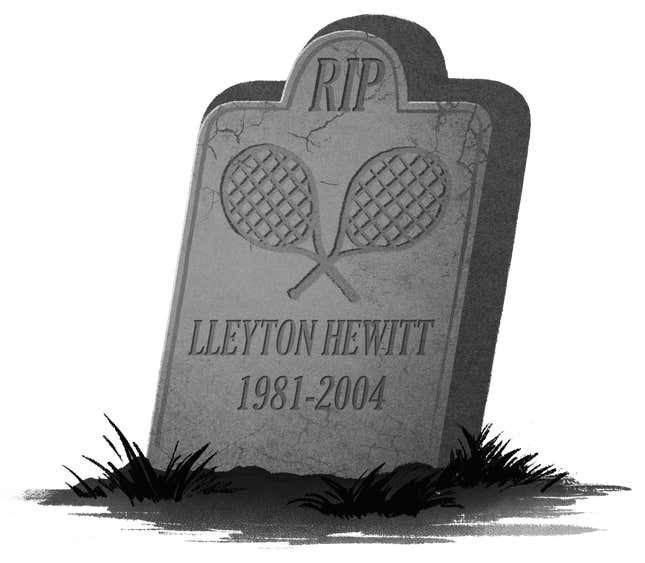
“Lleyton Hewitt?” I thought. “What’s a ‘Lleyton Hewitt’? Is that two couches from Pottery Barn?”
Before I could do anything else, I felt myself getting sucked in.
Shwwooooooooooooopppp.
I’m courtside at a tennis match, and a very young man, still wet from childbirth, is just playing the shit out of some tennis. He’s absolutely wiping the court with his opponent, and also visibly going at it harder than anybody has ever tried at anything. He’s not making any particularly devastating shots, or scoring many winners, but he’s imposing himself on the present moment, shrieking like a banshee after points, shouting lines from Rocky at himself, and pumping his fist until his face turns red. He looks terribly alone.
Shwoooooopppp. I’m transported again, this time to the final of the 2004 U.S. Open. The same man, who the scoreboard says is named “Lleyton Hewitt,” is playing ... hey, he’s playing my friend Roger Federer!
“I’m sorry for entering your property!” I try to shout to Roger from the stands, but no seems to hear me.
The young man looks more alone than ever now. He has no centering point, and in just 18 minutes he’s lost the first set 6-0. People are still trying to find their seats. He’s not playing bad tennis, it just looks like he’s playing the wrong tennis. It looks like he’s completely lost control of his physical environment, like a really fast sailboat in a storm, with no compass.
It gets worse. My Pal Roger keeps serving and playing more and more aggressively. He overdoes it a little in the second set and the whimpering infant works his way to a tiebreak. He loses. The match withers away from him again, and I see the ghost of his former self—of Lleyton Hewitt: World’s Best Tennis Player—ascend into the sky above Arthur Ashe Stadium, where it gets hit by a helicopter. Nobody else seems to notice.
Shwooooppp.
I was back at the graveyard, breathing heavily. What is this place?
“You there!” said a voice from behind me, causing my heart to leap into my mouth.
It was a tall, cloaked figure carrying a lantern. His hood was obscuring his face.
“Listen to me: you must leave Roger Federer’s property at once. It’s not safe here.”
“What do you mean?” I said. “Based on what I’ve heard, Roger Federer is one of the nicest guys out there.”
The figure let out a hearty, booming laugh.
“‘Nice guy,’ huh? Well then how do you explain that?” he said, pointing at another gravestone.
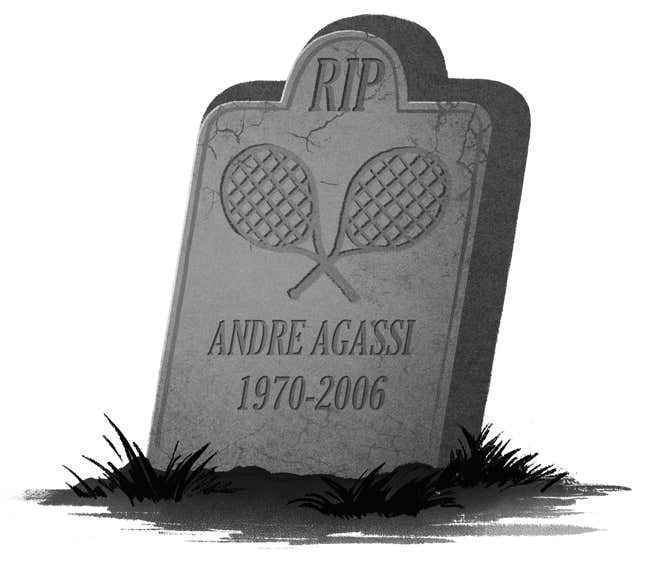
Shwoooooooop.
It’s flashes now, like a half-remembered dream. I see an insane, abusive father taping ping pong paddles to an infant’s hands, and that child trying to shake them off. I see that violent shaking becoming the foundation of a playing style, impatiently swiping at the ball earlier than anyone would consider possible. Then I hear a voice, clear and even: “I play tennis for a living even though I hate tennis, hate it with a dark and secret passion and always have.”
Then I see the infant as an angry and strangely dressed man, a man named Andre Agassi, whose self-loathing shines as brightly as his Air Tech Challenges. I see him losing to Roger Federer, a man who clearly loves tennis and thereby forces Agassi to do the thing he is least comfortable doing: play.
Long, fun, exciting rallies. Creativity. Play. This is Agassi’s ultimate punishment. I see him losing eight straight matches before passing away, tennis-wise, at the age of 36.
Shwwooooop.
The cloaked figure was leading me to another part of the graveyard now, and we were passing by dozens of smaller gravestones:
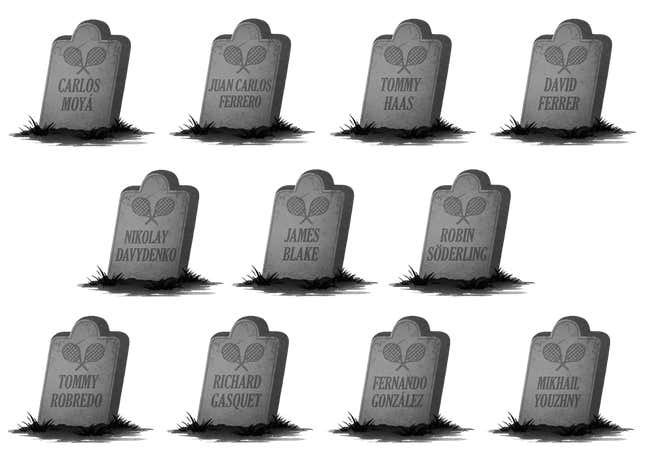
I recognized none of these names.
“Or how about this!” said the figure. We had stopped at the largest grave in the whole graveyard.
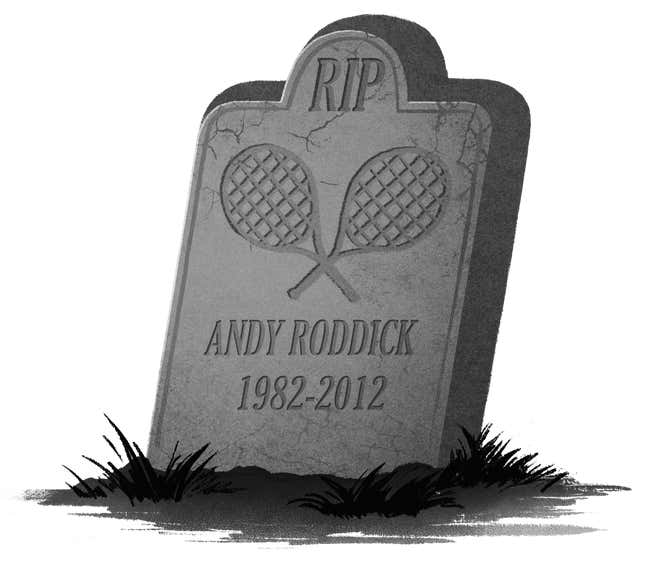
Shwooooopp.
I’m at a press conference now? Roger Federer is giving an interview, and I’m sitting in the audience, honestly a little bored.
“Not a press conference, not an interview,” says the cloaked figure, who is sitting beside me. “A funeral. A eulogy.”
What? Who is this guy? Just then Roger says:
“It’s been hard for him at times, but I always thought he did the best he could, and that’s all you can ask from a guy like Andy.”
Wait a minute, I remember Andy Roddick. He was the #1 player in the world! He won the U.S Open! Think about what it means to be (even relatively briefly) the. best in the world at something, anything, and then how condescending it is for another guy to say ‘Well, he did his best.’ All you can ask is that he win the U.S. Fucking Open?
That wasn’t very nice of Roger to say. Not very nice at all.
“That is closer to the truth,” says the figure.
“Can you hear my thoughts?” I think, loudly.
“Yes.”
Shwwoooooooop.
I see a flurry of matches, now, all of them The Most Important of Andy Roddick’s Life. The 2003 Wimbledon final, the 2004 Wimbledon Final. The 2005 Wimbledon Final. After a long pause, the 2009 Wimbledon Final, and Roddick is playing out of his goddamned mind. He has a backhand, a whole new outlook on life, and a Lacoste contract. He’s also got the first set, and four set points in the second. Holy shit, I think, Andy Roddick might finally do it.
He doesn’t. He doesn’t even come close, blowing the next five points in record speed. I feel like I’m watching every single match Andy Roddick has ever played simultaneously.
Andy Roddick would be the player you’d create if asked to design a player around the polymer strings. They develop shitloads of power, so you would naturally want to pair them with a really powerful guy; do it right and he’ll bully people right off the court. Roger Federer would be, like, the third or fourth thing you’d think of, using a blend of polymer strings and natural gut to make a guy with great control and a lot of angle capable of hitting those weirdo, off-the-wrong-foot shots with perfect placement and enough pace to evade the best players in the world. The latter strategy isn’t just better than the first, it’s consistently dominant. Incidentally, Nick Kyrgios and Gael Monfils are the unintended byproducts of your experimentation. Ah shit, you think, that didn’t go right at all.
“Stop fucking around,” says the cloaked figure, “Deadspin gave you a word count.”
I brace for another Shwoooopp.
Shwoooooooppppp.
I’m back at the graveyard, in front of another massive headstone.
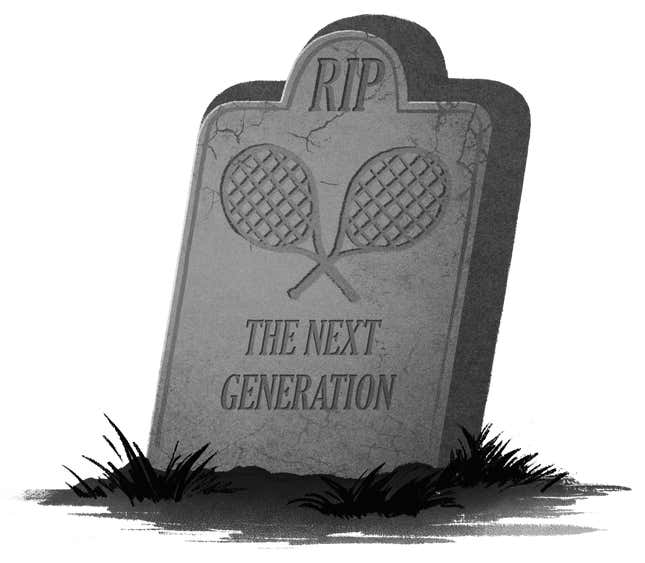
Shwoop.
I’m watching a younger Roger Federer playing one of his first professional matches against Andre Agassi. I notice him do a little stutter at the beginning of each service motion, clearly copying his idol Pete Sampras.
Fast forward two decades: a young man named Grigor Dimitrov is doing the same thing to every component of Roger Federer’s game.
He’s playing against Roger Federer, at a masters event or something, and illuminating the world of difference between looking and playing like Roger Federer. Exploiting this difference is Federer’s strategy against Grigor, who, to put things bluntly, doesn’t have The Shots. Federer humiliates him by constantly forcing Grigor to come up with The Shots.
Now Roger is humiliating another young gun: Milos Raonic, who clearly hates coming to the net and rallying. So Federer traps him in terrible lengthy baseline exchanges and hits lots of sneaky dropshots to lure Raonic’s lanky ass to the net, where Roger feasts on him like a helpless gazelle.
Now it’s the final of Wimbledon 2017. Roger Federer is sitting on his bench, relaxed, having a drink of water. Across the net is Marin Cilic weeping big, anguished tears on the court. Everyone feels really sorry and uncomfortable. After a few minutes of this, after it looks like he’s gathered himself up and the worst of it might be over, Federer tightens the screws, serving even harder and playing even riskier tennis just to beat him more completely.
I see Roger Federer defeating two entire generations of tennis players, not by playing pretty tennis, but by forcing every single one of his opponents to confront whatever it was they are most uncomfortable doing.
Swhhhoooowwwooppp.
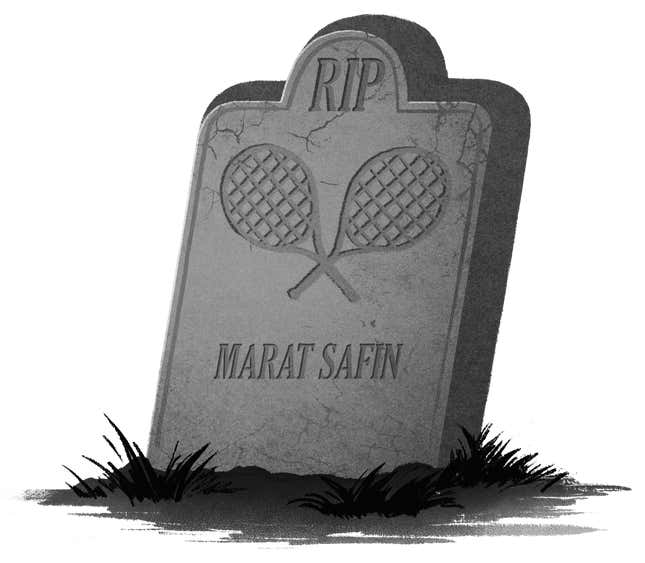
This grave is empty, and it’s for a guy named ‘Marat Safin.’
“Two Ikea couches?” I say aloud.
Shwwoooooooooppp.
The 2005 Australian Open seminfinal. Hey! It turns out mysterious cloak guy is Marat Safin. He’s no longer wearing his cloak and he’s playing some incredible tennis. I look across the net and see that his opponent, Roger Federer, has transformed into an unrecognizable monster.
He’s pissy. He’s angry. He’s shouting, snarling and cursing after every single lost point. Wait, did he just throw his racquet?
Here is the younger, more fragile, volatile Federer that I’ve heard stories about. A Federer with a darker side and a temper.
He’s not mad, in this moment, because he’s playing badly; he is, in fact, playing the best tennis of his life. He’s angry because no matter how hard he tries, he’s unable to put his opponent into an uncomfortable position.
He can’t do it because Marat Safin, a man with (arguably) more gifts than Federer, maybe the most talented man ever to play tennis, is finally using every single one of those gifts and playing the kind of “transcendent” tennis that people talk about when they talk about Federer.
Shwwwwwwwwwwoooooooooooooooooopppppppp.
“That match was a brain fight. I said it then, and I’ll say it again now: a Brain Fight.”
Safin and I were back in the graveyard now.
“Everything was working for me that day—serves, groundstrokes, volleys, even my mental game, and I became just as versatile as Roger. For every adjustment he made, I had an answer. For every move, a countermove. And Federer hated that shit.”
“For a few hours I revealed the real Roger Federer: a ruthless, dangerous man whose game plan is to make you uncomfortable, and who will fucking flip if you return the favor.”
I thought deeply about what Marat Safin was trying to tell me.
“Okay, I think I’m starting to see your point,” I said.
“I have to go now, but I have two things to tell you: Do not play tennis with Roger Federer. Under any circumstances,” warned Safin.
“I thought maybe—”
“No. The second thing is: don’t ever call me on the telephone. I’ll fucking kill you.”
He vanished. At that moment, Roger Federer emerged from the forest wearing an exquisite set of tennis whites, and my heart started beating really fast.
“Pretty cool graveyard, huh?” he said.
“Yes, very cool graveyard,” I said, trying to act normal and relaxed. “Listen, Roger, I should really get going.”
“Oh of course. But maybe before you go, we could hit?”
Roger Federer wanted me to play tennis with him. How could I say no? As I tried to think of an excuse, I looked down and I realized that I was already wearing my tennis clothes and that we were standing on a spooky, graveyard-themed tennis court. Federer’s four children, two uncanny sets of identical twins, stood beside the court, staring at us wordlessly.
“Wellll ... Maybe one set.”
“Perfect. Oh, by the way, I hope you’re not afraid of heights.”
Before I could answer, the court began to rise twenty stories into the air.
“Also, your ex-wife’s husband is here.”
There he was, mingling with my ex-wife and some other dinner guests near the middle of the court. It was clear that if I wanted to come net I would have to interact with them.
“That’s fine.”
“Great. Oh, sorry, one second,” said Federer, reaching for his ringing cellphone.
“It’s your student loans officer, he says he wants to speak with you during the first changeover.”
“Okay.”
“Great,” he smiled, hanging up the phone.
“Now let’s play tennis!”
Nick Zarzycki and Alex Kilpatrick are co-hosts of The Nick Kyrgios Podcast.